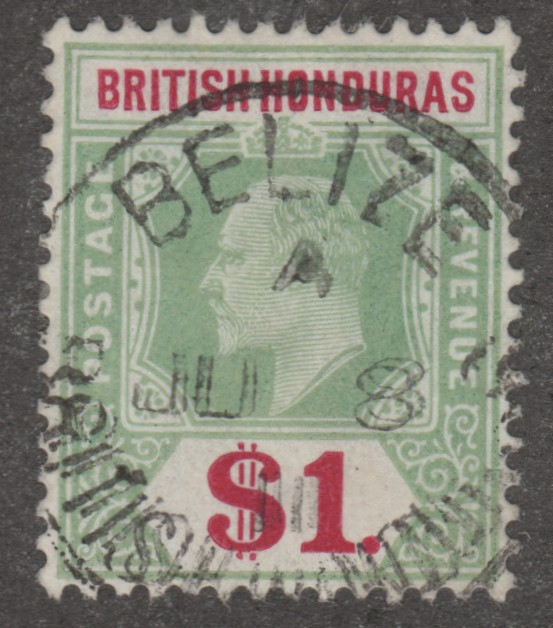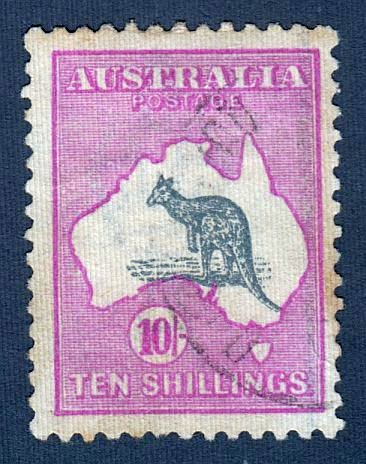
Discussion - Member to Member Sales - Research Center

Discussion - Member to Member Sales - Research Center


11:38:17am
Philippines: Japanese Occupation Scott #N22 MNH $0.35
Roy

Login to Like
this post
Hi Roy,
Just curious... how did you know that?
I can of course tell that it is a stamp from an Asian country, but beyond that, I would not naturally know that it was a stamp from the Philippines.
I'm a newbie, so maybe some obvious "signs" alluded me here...
Thanks!
JR

Login to Like
this post

03:08:55pm
"Just curious... how did you know that?"
57 years of looking at stamps.
Roy

3 Members
like this post.
Login to Like.
Man, I knew you'd say something like that...!!! 
JR

1 Member
likes this post.
Login to Like.
There is also, imho, an excellent illustrated stamp identifier in the back of every volume of the Scott catalog. It's for those stamps that don't have Roman-alphabet writing on them. It's the same in each volume.
For those stamps that do have some Roman lettering on them, the index at the back of each volume will also get you to the right country. If the country is listed in the particular volume you're looking in, it'll refer you to the right page in that volume. If it's in a different volume, then the index will direct you to the correct volume number. You then need to look it up in the index in the destination volume, and it'll give you the page number.
Admittedly, the index means that it's at its most useful having the full 6-volume set handy, but the illustrated stamp identifier, immediately before the index, is the same no matter the volume.
Also, check with your local library and see if they carry the Scott catalogs. If not, perhaps the main branch in the next largest city does (in the US). And while the most current set will likely be in the non-circulating reference section, oftentimes the next-most recent ones (and sometimes a few years prior) do circulate and so are available for checkout.

Login to Like
this post
Thank you, very right.
Forgot about the identifier in Scott.
And in this case exactly the series is shown.
Will make sure I check there first next time.
I have an idea I actually found this little stamp there years ago.
Thousands of stamps makes it difficult to keep track of what is done or not.
Stamp collecting is prolly the ultimate in patience and persistence.
Takes years to find a good enough reason to take the time to research low value stamps.
That is what makes stamp collecting so valuable in all walks of life.
A lonesome option though.
benjamin

2 Members
like this post.
Login to Like.
Benjamin, I hope I didn't come across sounding like, "why didn't you check in Scott first?" or any such thing.
I know that JohnnyRockets is pretty new to the hobby, and I suppose I had him in mind in preparing my response.
Please accept my apologies if I came off sounding snarky -- that was absolutely the opposite of my intention.
And glad you have a Scott's handy!

1 Member
likes this post.
Login to Like.
Dave,
No, I appreciate the reminder and no problem at all.
I just found a huge challenge, listing the Vietnam's. A total nightmare !!!
There are about 200 and I seem to have handled half so far.
The rest are tedious and time consuming. No dates or indications.
My motto is to give my customer as much detail as possible, not that it is always correct.
In this way, I also get to enjoy the logics in stamp collecting.
Causes me many queries but I stick to it.
Thanks again. benjamin

1 Member
likes this post.
Login to Like.
hi.dave. thanks for the tip on using the scott catalogue, I will have to remember to do that as well. all the best ken.

1 Member
likes this post.
Login to Like.
Hi Dave,
Oh yes I am SUPER new to the hobby (as most know), and appreciate every single tip I can get.
I actually have one volume of the Scott's album, but have not had a lot of time to look at it, but now my interest is very peaked and I will be looking at that tonight.
Thanks guys for helping me and for this great thread!
JR 

1 Member
likes this post.
Login to Like.
For those who don't have access to a printed catalogue there are a number of stamp identifier sites on the internet, diligent use of google will will locate a few - choose the one which seems to suit you.
As a guide Japanese and Chinese language inscriptions, while being superficially similar are actually quite different, and observation shows that yours is definitely Japanese. Also after a short while you can tell from just looking at the design of the stamp ( which has many characteristics of Japanese stamps of the period ) the approximate period it was produced - in this case 30s to 40s, so a Japanese Occupation of somewhere is a fairly safe bet , but then that is where the experience comes in.
Incidentally you notice that I don't mention Korean or Tibetan inscriptions !!
Malcolm

Login to Like
this post
10:24:17am
Please help identify this stamp.
MNH 

Login to Like
this post
BuckaCover.com - 80,000 covers priced 60c to $1.50 - Easy browsing 500 categories
06 Jun 2018
11:38:17am
re: Asian stamp.
Philippines: Japanese Occupation Scott #N22 MNH $0.35
Roy

Login to Like
this post

re: Asian stamp.
Hi Roy,
Just curious... how did you know that?
I can of course tell that it is a stamp from an Asian country, but beyond that, I would not naturally know that it was a stamp from the Philippines.
I'm a newbie, so maybe some obvious "signs" alluded me here...
Thanks!
JR

Login to Like
this post
BuckaCover.com - 80,000 covers priced 60c to $1.50 - Easy browsing 500 categories
06 Jun 2018
03:08:55pm
re: Asian stamp.
"Just curious... how did you know that?"
57 years of looking at stamps.
Roy

3 Members
like this post.
Login to Like.

re: Asian stamp.
Man, I knew you'd say something like that...!!! 
JR

1 Member
likes this post.
Login to Like.
04:53:44pm
re: Asian stamp.
Well done, thanks Roy.

Login to Like
this post

re: Asian stamp.
There is also, imho, an excellent illustrated stamp identifier in the back of every volume of the Scott catalog. It's for those stamps that don't have Roman-alphabet writing on them. It's the same in each volume.
For those stamps that do have some Roman lettering on them, the index at the back of each volume will also get you to the right country. If the country is listed in the particular volume you're looking in, it'll refer you to the right page in that volume. If it's in a different volume, then the index will direct you to the correct volume number. You then need to look it up in the index in the destination volume, and it'll give you the page number.
Admittedly, the index means that it's at its most useful having the full 6-volume set handy, but the illustrated stamp identifier, immediately before the index, is the same no matter the volume.
Also, check with your local library and see if they carry the Scott catalogs. If not, perhaps the main branch in the next largest city does (in the US). And while the most current set will likely be in the non-circulating reference section, oftentimes the next-most recent ones (and sometimes a few years prior) do circulate and so are available for checkout.

Login to Like
this post
06:29:47pm
re: Asian stamp.
Thank you, very right.
Forgot about the identifier in Scott.
And in this case exactly the series is shown.
Will make sure I check there first next time.
I have an idea I actually found this little stamp there years ago.
Thousands of stamps makes it difficult to keep track of what is done or not.
Stamp collecting is prolly the ultimate in patience and persistence.
Takes years to find a good enough reason to take the time to research low value stamps.
That is what makes stamp collecting so valuable in all walks of life.
A lonesome option though.
benjamin

2 Members
like this post.
Login to Like.

re: Asian stamp.
Benjamin, I hope I didn't come across sounding like, "why didn't you check in Scott first?" or any such thing.
I know that JohnnyRockets is pretty new to the hobby, and I suppose I had him in mind in preparing my response.
Please accept my apologies if I came off sounding snarky -- that was absolutely the opposite of my intention.
And glad you have a Scott's handy!

1 Member
likes this post.
Login to Like.
07:02:28pm
re: Asian stamp.
Dave,
No, I appreciate the reminder and no problem at all.
I just found a huge challenge, listing the Vietnam's. A total nightmare !!!
There are about 200 and I seem to have handled half so far.
The rest are tedious and time consuming. No dates or indications.
My motto is to give my customer as much detail as possible, not that it is always correct.
In this way, I also get to enjoy the logics in stamp collecting.
Causes me many queries but I stick to it.
Thanks again. benjamin

1 Member
likes this post.
Login to Like.
re: Asian stamp.
hi.dave. thanks for the tip on using the scott catalogue, I will have to remember to do that as well. all the best ken.

1 Member
likes this post.
Login to Like.

re: Asian stamp.
Hi Dave,
Oh yes I am SUPER new to the hobby (as most know), and appreciate every single tip I can get.
I actually have one volume of the Scott's album, but have not had a lot of time to look at it, but now my interest is very peaked and I will be looking at that tonight.
Thanks guys for helping me and for this great thread!
JR 

1 Member
likes this post.
Login to Like.
05:22:48pm
re: Asian stamp.
For those who don't have access to a printed catalogue there are a number of stamp identifier sites on the internet, diligent use of google will will locate a few - choose the one which seems to suit you.
As a guide Japanese and Chinese language inscriptions, while being superficially similar are actually quite different, and observation shows that yours is definitely Japanese. Also after a short while you can tell from just looking at the design of the stamp ( which has many characteristics of Japanese stamps of the period ) the approximate period it was produced - in this case 30s to 40s, so a Japanese Occupation of somewhere is a fairly safe bet , but then that is where the experience comes in.
Incidentally you notice that I don't mention Korean or Tibetan inscriptions !!
Malcolm

Login to Like
this post

